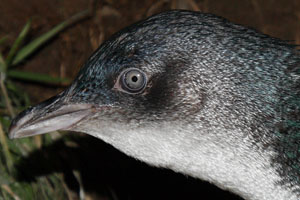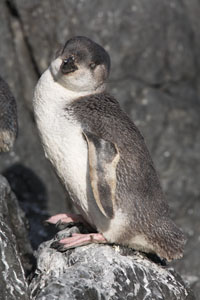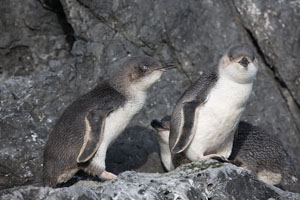Little penguins tend to be very faithful to nesting sites. Similarly, pair bonds are strong and are commonly maintained over many seasons. This may be the result of the nearly year-round presence at the colony. Less than 1% of penguins are thought to move to other colonies during their lifetimes. Nesting occurs in underground burrows, usually in soft ground near beaches. Burrows may be dug if necessary using bills and feet. They are usually at least 2 meters apart and burrow entrances are defended vigorously. Nesting under houses or in artificial nest boxes is also common. The latter suffer the disadvantage of elevated temperatures inside when exposed to the sun (Ropert-Coudert et al., 2004. Wildlife Soc. Bull. 32(1), p.177-182), although breeding success appears similar in nesting boxes compared to natural nests (Klomp et al., 1991. Emu 91, p.190-193). Plant materials including grasses and seaweed is used to line nests. Males may occupy a nest first, or find a partner before doing so, depending on the colony. Courtship displays may vary according to nesting conditions. For example, in narrow burrows a classic upward-stretched ecstatic display may not be possible. Copulation also occurs in burrows. Drumming of the males flippers on the female, which generally precedes copulation may be audible outside burrows.
Both burrow and mate fidelity have been statistically analysed at Lion Island, NSWales, Australia (Rogers and Knight, 2006. Ibis 148, p.801-806). Over 75% of both male and female birds return to the same nest in subsequent years. Virtually all other birds moved to nests close by in the same part of the colony. Lower figures have been reported from other sites. Although successful breeders returned to their old nest slightly more often, no statistically significant correlation between previous breeding success and nest fidelity was found. Mate fidelity reached nearly 90% if both partners returned to the colony the next breeding season. However, nearly half of the pairs from the previous season could not reunite since at least one partner did not return to the colony. This was more common in birds that had experienced breeding failure, possibly as these birds were weaker and thus more likely to die or arrive late or not at all at the breeding site. Interestingly, whilst successful breeders were more likely to both arrive back at the colony, their divorce rate is slightly higher than that of unsuccessful breeders that both managed to return. It is possible that this reflects early arrival at the colony of many of these birds and unwillingness to wait for the old mate.
The main breeding season usually commences around september in New Zealand, although when food is plentiful eggs may be laid from May to February, with two pairs of chicks being raised in some cases. At other sites, different times may be preferred depending on local climatic influences. Egg laying is not strongly synchronized between individuals in a colony. After the two eggs have been laid, one parent must incubate whilst the other forages. Little penguins usually perform single day foraging trips, with longer trips becoming more common during the incubation period as parents alternate with incubation duties. When food is scarce, these trips may last for a week. However, long trips may precipitate egg desertion by the incubating bird (Numata et al., 2000. NZ J. Zool. 27, p.277-289). Based on studies with King penguins, it has been suggested that when a critically low level of body fat and/or protein reserves is reached in the incubating penguin, the nest will be deserted so that it can go to sea and feed (Olsson 1997. J. Avian Biol. 28, p.264-267). Hence, both duration of partner absence and body condition play a role in desertion. A probably hormonally triggered decrease in foraging trip lengths has been noted towards the end of the incubation period, ensuring that the chicks can be fed reasonably soon after hatching. The incubating parent is unlikely to have enough food left in its stomach to feed the chicks, since meals are usually digested within 16 hours (Gales 1987. Ibis 129, p.335-343). Chicks tend to starve if not fed within 3 days of hatching.
Eggs usually hatch within 1-3 days of each other after an incubation period of about 37 days. After hatching, parents continue to alternate in guarding the chicks (Guard Period). A mostly daily alternation of nest attendance can be observed during this period. Guarding is necessary until chicks can thermoregulate themselves, and also serves to protect against predators. Guard Periods ranging from 10-28 days were observed in comparative studies of two colonies in Numata et al., 2004 (NZ J. Zool. 27, p.277-289). Penguins in colonies where food is scarce appear to brood chicks for less long (due to the need for both parents to forage), and similarly when 2 chicks are being raised, brooding is shorter than when only a single chick is being raised (since both parents need to forage sooner to feed the additional chick). When food is scarce the chicks may be abandoned, resulting in starvation. For example, a third of chicks were abandoned on Motuara Island (NZ) in the 1998/99 breeding season when pilchard levels were below average. Parents may preferentially feed a single chick, resulting in death of the other. This form of brood reduction strategy may ensure survival of at least one chick. After the Guard Period, chicks stay alone in nests and may come to the entrance (if nesting in burrows) at dusk to await the adults. Creching is unusual but may occur when birds live together in large caves. After about 8 weeks fledglings may go to sea. The body mass at fledging correlates with survival in the first year (Dann 1988. Emu 88:101-103). Young birds may stay far from the colony until reaching sexual maturity at an age of 2-3 years when they usually return.
The ability to raise two pairs of chicks in one breeding season makes the little penguin unique among penguins. Birds laying two clutches raised 1.7 times as many chicks as single clutch parents, with fledging chicks having equal chances of survival as those from single clutches. Birds are more likely to lay two clutches as they get older, and it also appears that these birds have above average survival rates, above average breeding rates in subsequent seasons and the increased propensity to raise 2 clutches again in subsequent seasons (Johannesen et al., 2003. J. Avian Biol. 34(2), p.198-210).
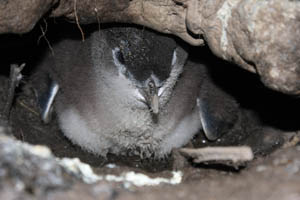 |
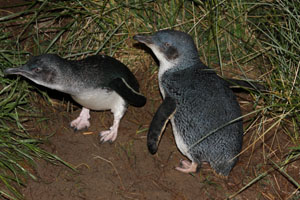 |
|
Little penguin chick in nest burrow, Otago Peninsula, NZ
|
Little penguins in front of nest burrow, Otago Peninsula, NZ
|
|
